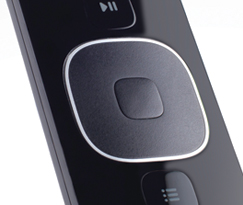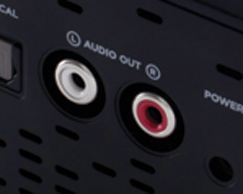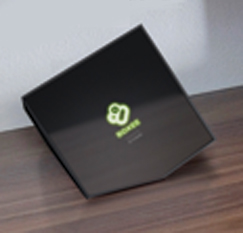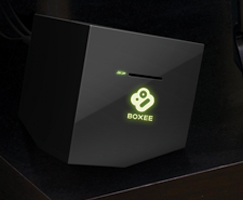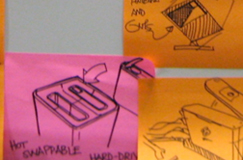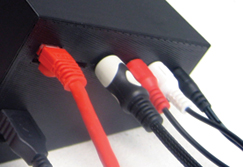We have entered the age of the Smart TV. Through a set top box or technology integrated into the TV itself, you can now enjoy free and paid for content on the internet from the comfort of your couch.

Boxee concept sketches
Although there are now many players in this market place, a small US company – Boxee – that once had lofty ambitions of taking the Smart TV industry by storm is now doing just that. Its first device is a sleek, asymetrically aligned cube that breaks with tradition with a shape that can’t be stacked.
The Boxee Box plugs into the back of the TV and connects to the web via a wired or wireless N network connection. Users can watch movies and TV programmes from the internet, stream videos from nearly any website, exchange recommendations with friends through social media sites as well as organise personal music, photos and videos. It also comes with a nifty remote that incorporates a QWERTY keyboard on the underside.
“My favourite bit about Boxee is that even on its first boot up, the TV Show and Movie libraries are already pre-populated with thousands of titles from sources we’ve indexed online. Every Boxee device is an internet jukebox ready to play,” explains Zach Klein, Boxee’s chief product officer.
Small beginnings
Five friends founded Boxee in 2007 with the idea of providing free, open source software over the internet. It soon caused quite a stir with users downloading the software and installing it on any computer capable of being connected to a TV.
By converting an iPhone into a remote, or using a simple PC remote, users could then sit back and watch online content on a bigger TV screen. Although this method of creating a ‘Boxee’ worked fine, the real challenge was then to make the software available to a wider audience. It soon became obvious that Boxee needed to create a standalone device that would perform the same role.
In order to achieve this Boxee increased its small team to 19 employees, including Klein who joined as head of product in September 2009. He was sought out for his knowledge and experience of the digital media industry having spearheaded a number of projects including co-founding and designing Vimeo.com, a popular video-sharing community.
“My role was created in an effort to unify the experience between every touch-point with our users, whether it be our software, our website, or the devices we power,” says Klein.
“In addition, my personal objective was to grow our software to better leverage the interesting and boundless content that is already freely and legally available online. I’m constantly inspired by the quality of community-generated videos on vimeo.com; I want to easily see that stuff on my TV,” he adds.
In practice
For Klein the software’s user interface was vitally important. As new users would be experiencing and interacting with Boxee for the first time through this device, it needed to be enjoyable and easy to use.
“We certainly already have a passionate and savvy user base, but I also knew that what we were making would be useful to anyone that currently uses the internet to watch video. I wanted them to try Boxee and for their experience to be intuitive and flawless,” he explains.
But the software is only half the story as Boxee now had to create the hardware that would match this interface. For Klein it was important that the hardware and software shared common characteristics, as they would both be expressions of the company, which, in his words, is creative, irreverent and just slightly odd.
“When we started the process there were only two givens: we didn’t want another ‘pizza box’, and the remote had to have a QWERTY keypad,” says Klein. The reason for including the QWERTY keypad on the underside of the remote was that instead of subjecting users to another on-screen keyboard, the remote would include a keypad that could be used as you would a smart phone.
Boxee established a partnership with D-Link, a global manufacturer of networking solutions, to produce the device and then went looking for an industrial design agency to create it. The agency chosen to bring this product experience to life was Astro Studios, which has racked up an impressive portfolio including the Xbox 360+, Microsoft ZuneHD and various Astro Gaming products.
“Being avid users of Boxee’s popular software we were inspired by the company’s irreverence, ingenuity and emerging technology,” comments Michel Alvarez, Astro’s lead designer.
“Its always an exciting opportunity to help develop a new product for an emerging brand. In the case of Boxee Box, we had full support from their team to create something radical and unique, and as designers we are always looking for opportunities like these to make an impact in the consumer world,” he adds.
The initial meeting between the two companies allowed Astro to get a better understanding of the functional requirements of both the main unit and remote. It also revealed the iconic impact Boxee was looking to make, as Alvarez explains
“The Boxee Box was to be their flagship hardware and our goal was to capture the whimsical nature that is ‘Boxee’ while delivering a design that would be memorable and respected as a high-end piece of home electronics.”
Thinking caps
Astro kicks off its design process with a group brainstorming session to capture initial thoughts, details and themes. No idea is ever discarded and all are built upon in order to create, what Alvarez calls, “mild to wild” product themes. In the case of Boxee, a wide range of set top boxes with unique proportions and animate gestures were explored.
“Traditionally we use large Post-its and sketch various concepts and stick them onto a large project wall where we can see them all,” describes Alvarez. “Once we feel we have enough of a range, we begin to move and categorise some of these themes into larger ideas, adding support imagery or sketches to the wall.”
The most promising concepts are then developed into rough foam core models to further evaluate their impact on actual scale. One of the wilder concepts was the idea of a three-dimensional cube emerging from a flat surface. The designers felt that this pure, geometric shape highlighted the simplicity of Boxee’s software.
“When building the ‘emerging box’ we knew that we had landed on an ownable product theme that was simple and obvious,” says Alvarez. “For us the emerging box symbolised Boxee’s emerging technology and their out-of-the-box approach to internet TV.”
However, is this really a practical shape or is it merely a case of style over substance?
“Although the emotional aspect of the design drove the exploration, there are several practical improvements that compliment the asymmetrical design of the box,” argues Alvarez.
“For example, the tilted angle of the box helps to naturally drape the multitude of cables from the rear of the device, improving the stability of the unit on a tabletop edge. This angle also helps funnel the cables in one main direction integrating them into the animate gesture of the product.”
In fact, Alvarez explains how each side of the box delivers a functional aspect of the product experience. On the front the Boxee logo communicates whether the device is on or off. When off, the front reveals a sleek, mirror-like surface but when switched on a green Boxee logo mysteriously emerges from the darkness.
The adjacent side presents the SD media slot, which has been shaped to mimic the Boxee logo’s mouth. The power button has been designed as a surface undulation on the tapering top surface, while the bottom of the unit is secured with green, non-slip rubber helping to ground the product.
Key attraction
As well as the box, Astro also designed the double-sided remote. “Our simple remote divides the user’s interaction into two major sides; the more traditional multimedia side and the more in depth QWERTY side,” says Alvarez.
“The multimedia side features a simple four-way nav with two additional buttons (play/pause and menu), which are all centred on the remote so as to not be pressed accidentally when typing on the QWERTY side.
“The QWERTY side contains a full keyboard of letters and symbols, similar in size to a mobile phone keyboard, that are pocketed into the main surface so they are also not accidentally pressed when rested onto a table. The feel and size of the keys help deliver an integrated keyboard experience while the sheer simplicity and intelligence of the design makes it uniquely Boxee,” he continues.
Astro makes use of a number of design tools. During the design process, the designers primarily use Alias, Rhino, and SolidWorks. In the case of the Boxee Box project, Alias was used to develop early design variations of the main unit and SolidWorks helped refine the remote. In parallel, Illustrator and Photoshop were used to finalise all design details including rear venting and de bossed graphics.
“We also developed photorealistic renderings in Bunkspeed Hypershot and eventually a set of appearance models that helped further define the look and feel we were after for production,” explains Alvarez.
Look and feel
Using the CAD data developed for the main unit the designers created prototypes using Fused Deposition Modelling (FDM) additive technology. This helped them to fine-tune certain design elements on the box such as the rear cable interactions.
When it came to the remote, several rough foam models were initially created with keyboard and button variations spray mounted to each side. These were then tested by a range of Astro employees of varying hand sizes in order to really evaluate the proportions and get the ergonomics right. The look and feel was then further refined through several FDM prototypes reflecting the actual volume and weight of the proposed design.
Once the design of both the main unit and remote were finalised, the CAD files were translated into Pro/Engineer for mechanical engineering and ultimately manufacturing. Both the engineer and D-Link use Pro/E so this meant that they could efficiently work back and forth between themselves as the design progressed through manufacture. “There were certain trade-offs along the way, but having all parties aligned on the same vision made it easier to preserve the original design intent all the way through production,” says Alvarez.
Show time
Launched at the Consumer Electronics Show (CES) in January 2010, Boxee Box was certainly a showstopper outshining many of its competitors. The device received both the ‘Last Gadget Standing’ award as well as being a ‘Best of Innovations’ Honouree in the Home Entertainment category.
Since then D-Link and Boxee have worked closely to add further capabilities and content to the platform. The Boxee Box shipped towards the end of 2010 and is now available in over 30 countries. In the UK you can get your hands on one for £199.
Boxee realises that in such a fast paced industry you can’t afford to rest on your laurels. “We’re never satisfied as perfection is always on the horizon,” says Klein. “The nature of video on the internet is changing quickly, as well as the mainstream user’s sophistication with technology, so we’re continuously challenged to iterate.”
This attitude was demonstrated at the most recent CES in January 2011 with Boxee announcing a partnership with HDTV manufacturer Viewsonic who will deliver the first TV with Boxee software embedded directly into it. Although this means that you no longer need a Boxee Box if you want to watch internet-based TV, there will no doubt be consumers who may opt to do so because of the emotional attachment they have formed with their quirky, sunken cube.
www.boxee.tv | www.astrostudios.com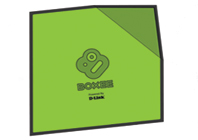
Welcome to the age of Smart TV


